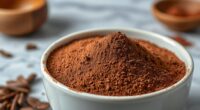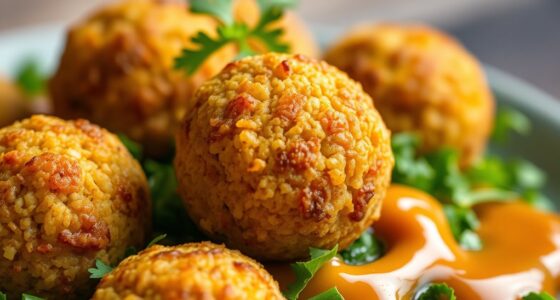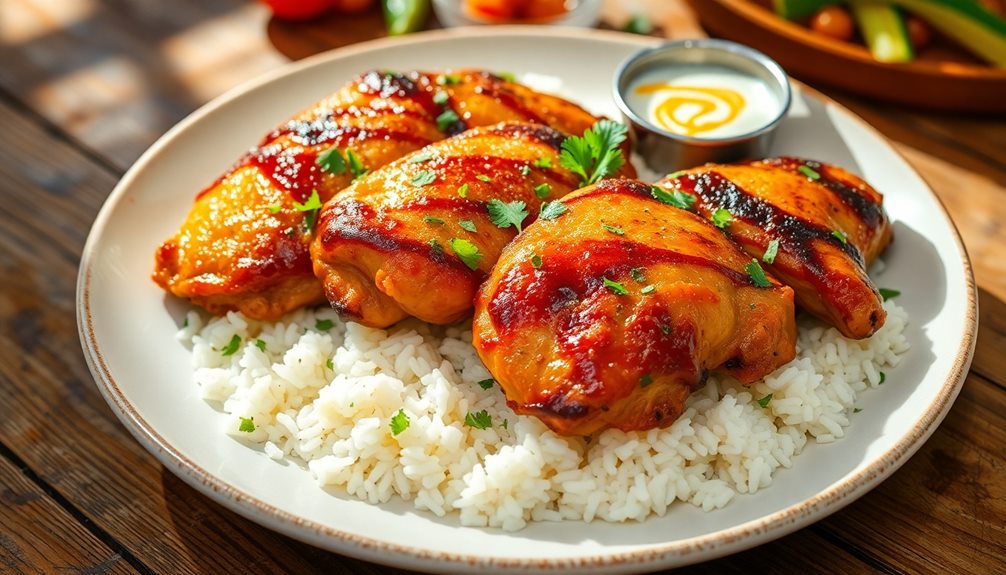Yemeni spice blends like Hawaij bring centuries of tradition into your kitchen, adding depth and warmth to your dishes. This blend combines toasted cumin, coriander, turmeric, and other aromatic spices, all roasted fresh to maximize flavor. Use Hawaij in stews, soups, or rice for an authentic touch that transports you to Yemen’s rich culinary heritage. Exploring further will reveal even more ways to enjoy its unique flavors and regional variations.
Key Takeaways
- Hawaij is a traditional Yemeni spice blend with centuries-old origins, adding rich depth and warmth to dishes.
- It comprises roasted cumin, coriander, turmeric, cardamom, and black pepper for a complex flavor profile.
- Regional variations—coastal and inland—offer different spice combinations tailored to local tastes.
- Toasting spices before grinding enhances aroma and flavor, making dishes more fragrant and authentic.
- Incorporate Hawaij into soups, stews, rice, or coffee to connect with Yemen’s culinary heritage and enhance depth.

Have you ever wondered what makes Yemeni cuisine so uniquely flavorful? The answer lies in its rich history and the vibrant tapestry of regional variations that influence every dish. Yemeni spice blends, especially Hawaij, are at the heart of this culinary tradition, offering depth and warmth that elevate simple ingredients into extraordinary meals. To truly appreciate Hawaij, it helps to understand its historical origins. This spice blend has ancient roots, dating back centuries when trade routes like the Incense Route facilitated the exchange of spices, herbs, and aromatic ingredients between Africa, the Middle East, and Asia. Over time, these influences merged to create a distinctive flavor profile, passed down through generations. Yemen’s rugged terrain and isolated valleys fostered regional variations, each with unique combinations of spices tailored to local tastes and available ingredients. In coastal areas, for example, Hawaij might include more citrus or aromatic herbs, while inland regions favor earthier, spiced versions with cumin, coriander, and turmeric. These regional differences make Yemeni cuisine incredibly diverse, yet all share a common foundation rooted in tradition and history. Additionally, the use of freshly toasted and ground spices enhances the aroma and flavor of the blend, connecting the culinary experience to centuries-old practices. The regional variations also reflect the diverse climate and geography of Yemen, influencing the ingredients used. When you cook with Hawaij, you’re tapping into this centuries-old legacy. Its blend of roasted cumin, coriander, turmeric, cardamom, and black pepper creates a warm, fragrant aroma that signals comfort and authenticity. The process of making Hawaij often involves toasting and grinding the spices fresh, which enhances their natural oils and intensifies their flavor. This blend is incredibly versatile and can be used in soups, stews, rice dishes, and even coffee. By incorporating Hawaij into your cooking, you’re not just adding flavor—you’re connecting with a cultural heritage that spans generations and regions. The regional variations mean you can tailor your spice mix to suit your taste or the specific dish you’re preparing. For example, a Yemeni-style meat stew might feature a richer, more spice-forward Hawaij, while a vegetarian dish could lean towards a milder, herb-infused version.
Frequently Asked Questions
Can Hawaij Be Used in Desserts or Sweet Dishes?
You might wonder if hawaij can be used in desserts or sweet dishes. While it’s primarily known as a savory spice blend, you can experiment with it as a unique dessert flavoring. Its warm, aromatic notes can add depth to sweet treats. Incorporate small amounts into sweet spice blends or sprinkle it on desserts to create a distinctive flavor profile. Just balance it carefully so the spice complements, rather than overpowers, your sweet creations.
How Long Does Homemade Hawaij Last Before Losing Potency?
They say, “A stitch in time saves nine,” and this applies to your homemade hawaij. Typically, proper storage extends its potency for up to 6 months, but after that, it starts to lose flavor. Keep it in an airtight container away from heat, light, and moisture to preserve its depth and warmth. For best flavor, use it within this period, as freshness truly makes a difference.
Are There Regional Variations of Hawaij Within Yemen?
You’ll notice regional variations of hawaij within Yemen, influenced by local flavor profiles and traditional preparation methods. In some areas, you might find more cumin and turmeric, creating a warmer, earthier taste, while others emphasize coriander and cardamom for a brighter aroma. These regional differences reflect local ingredients and culinary traditions, giving each hawaij blend its unique character and depth, making every version a special reflection of its community.
Is Hawaij Suitable for People With Spice Sensitivities?
Your spice sensitivity might feel like a tiny pebble in your shoe when you try hawaij. It’s a bold, warming blend, but if you’re sensitive to spices, it could overwhelm your palate. The good news? You can adjust the flavor by reducing or omitting certain spices, making it gentler. Always taste as you go and customize your spice blend to suit your comfort level—your taste buds will thank you!
How Can I Adjust Hawaij for Different Dietary Restrictions?
You can adjust hawaij for dietary restrictions by exploring substitution options and ingredient adjustments. If you’re sensitive to certain spices, try replacing cumin or turmeric with milder herbs or spices like coriander or ginger. For gluten-free diets, verify all ingredients are gluten-free. Experiment with small batches, and always taste as you go to find the right balance. This way, you customize hawaij to suit your specific dietary needs while maintaining its flavor depth.
Conclusion
Embrace the rich flavors of Hawaij and other Yemeni spice blends to transform your cooking. With each sprinkle, you’re adding depth and warmth that tell a story of tradition and culture. Remember, a little spice can turn an ordinary dish into something extraordinary—like a flame that ignites your senses. So don’t be afraid to experiment; after all, a journey of a thousand miles begins with a single step. Happy cooking!









